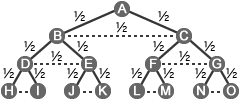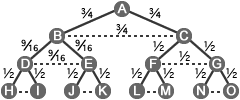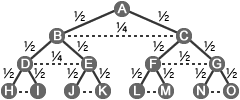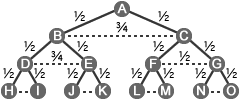Relatedness
Overview
This tutorial shows how to calculate the relatedness of two family members. It is meant to complement the Cooperation tutorial but can also stand on its own. The basic tutorial requires no background in game theory and takes less than 10 minutes. The optional section on complex relatedness patterns takes another 10 minutes.
Introduction
When studying the evolution of cooperation and conflict or lack thereof, we often want to know how closely two individuals are related, since that may affect the costs and benefits of their actions1. For this purpose, relatedness is defined as follows:
Relatedness is the probability that two individuals share an allele due to recent common ancestry.
This probability is expressed as the coefficient of relatedness, denoted by the symbol r. It ranges from 0 (unrelated) to 1 (clones or identical twins). The definition excludes alleles that are shared simply by virtue of being members of the same species or population within a species.
Calculating Relatedness
In diploid organisms, each child receives half of its genes from its mother and half from its father3. Thus each parent shares half its alleles with a child, and we say that parents and offspring are related by ½. Any two siblings are also related by ½. Each sibling receives half its genes from each parent. As a result, siblings could share no alleles (in the unlikely case that each child got the half of the genes from each parent that the other didn’t), all alleles (in the unlikely case that both children got the same set of genes from each parent), or anywhere in between. That averages to (0+1)/2, so siblings share half their alleles on average and r = ½. This example illustrates the point:

This hypothetical diploid organism has four chromosomes, R, S, T, and U. Each parent has two copies of each chromosome and each gamete (egg or sperm) carries only one of those copies. A child gets half its chromosomes from each gamete, so parent and child are related by ½. Since chromosomes segregate randomly into gametes, the actual proportion of alleles shared by any two siblings can vary. In this example, A and C share all alleles while B and D share none. A and B share ½ their alleles, as do B and C. A and D share only ¼, as do C and D. Considering all possible combinations of gametes, siblings share ½ of their alleles on average.
Given that parents and offspring are related by ½ and siblings are related by ½, we can calculate the relatedness of any family members. The reasoning about parents and children shows that a grandparent and grandchild are related by ¼, since one parent received half of its genes from that grandparent and then passed half of those genes on to its children. We can also follow that reasoning to show that you are related to an uncle or aunt by ¼. Your parent and his or her sibling share half their alleles, and half of those shared alleles were passed on to you from your parent.
If tracing genes from one generation to the next seems complicated, there is a simple graphical way to accomplish the same thing by looking at a family tree. Draw the tree as in the example below. Then mark the shortest possible path between two family members and count the number of steps between them. Each step across generations (parent to child) or between siblings counts as one. Once you have this number of steps (n), r = ½n, or ½ multiplied by itself n times.
Family tree: A is a parent of B and C, B is a parent of D and E, and so on. Only two siblings per generation are shown; if there are more, they are all related to each other by the same amount. Solid lines connect parent and child; dashed lines connect siblings.

For example, how are D and K related (niece or nephew to aunt or uncle)? There are two steps, D-E and E-K, so r = ½×½, or ¼. How are H and J related (first cousins)? There are three steps, H-D, D-E, and E-J, so r = ½×½×½, or ⅛. If you want more practice, try these examples. All refer to the above tree.
This concludes the basic relatedness tutorial, which is sufficient for most purposes.
Complications
Inbreeding
What if the parents are related4? Suppose r′ is the coefficient of relatedness between the parents. A child gets half of its genes from the father and half from the mother. Among the genes that it gets from the mother, there is a probability of r′ that those alleles are shared with the father. So the relatedness of child to father is ½ (genes from the father) plus ½ (genes from the mother) × r′ (probability that alleles inherited from the mother are also present in the father). The same reasoning applies to relatedness to the mother. Offspring are related to each parent by ½+½ r′.
What about siblings when parents are related? Each sibling receives half its genes from each parent. Even if each child got only the genes from the mother that it didn’t get from the father and vice versa, they would still share r′ of their alleles because of relatedness of the parents. At the other extreme, they could share all of their alleles in the unlikely event that both children got the same sets of genes from each parent. So their shared alleles could range from r′ to 1 or anywhere in between. That averages to (r′+1)/2, so r = (r′+1)/2, or r = ½+½ r′.
In general, when parents are related to each other by r′, they are related to their offspring by ½+½ r′ and these offspring are related to their siblings by ½+½ r′. When there is no inbreeding, r′ = 0 and we get the usual r = ½ for parent-child and sibling-sibling relatedness.
Mixed Families
What about half-siblings, who share only one parent? Parents are still related to offspring by ½, but siblings are related by only ¼. At a minimum, they might share no alleles (in the unlikely event that they get completely different sets of genes from the shared parent). At most, they could share ½ of their alleles (in the unlikely event that they both get the same genes from their shared parent). So allele sharing ranges from 0 to ½, which averages to ¼, so r = ¼ among half-siblings.
Haplodiploidy
In bees, wasps, and ants, females are diploid and males are haploid5. A reproductive female (or queen) passes half of her genes to her offspring, while a male passes all of his genes to daughters. (He has no sons, since males come from unfertilized eggs.) Males are related by ½ to their mothers and by ½ to siblings. Sisters are related by ¾. At a minimum, sisters share ½ of their alleles (all inherited from their father, with no shared genes from the queen). At most, they could share all of their alleles (half from their father, plus completely identical genes from the queen). So allele sharing ranges from ½ to 1, which averages to ¾, so r = ¾ among sisters.
Queens in many species of social insects mate with multiple males, so relatedness through the father is reduced. Sisters in these colonies are related by more than ½ but less than ¾ on average. In some cases, there are even multiple queens, reducing average relatedness still further. Both of these complications have interesting effects on cooperation and conflict in social insects.
Calculating Relatedness
How can we calculate relatedness in inbred, mixed, or haplodiploid families? The procedure is essentially the same as with regular diploid families. We can trace genes from generation to generation and calculate the probability that they are shared or we can use a graphical technique similar to the one above. However, we can no longer assume that all steps reduce relatedness by a factor of 2 (multiplying by ½). Instead, we must label our family tree with the known relatedness at each step. As you make your path through the tree, write down the relatedness at each step. At the end, multiply all of the r values to obtain the coefficient of relatedness. The four trees below illustrate this for sample unrelated, inbred, mixed, and haplodiploid cases.

Unrelated. This tree simply adds the relatedness of ½ between parents and offspring and between siblings when there is no inbreeding.

Inbred. A was related to its mate by ½ (siblings) and B was related to its mate by ⅛ (first cousins). No other parents are related.

Mixed. In this tree, B and C share only one parent, A, reducing their relatedness to ¼. Similarly, D and E share only one parent, B.

Haplodiploid. This tree shows a family of wasps with multiple queens. Only G is male; all the others are female. (Non-reproductive females are not shown.)
For example, what is the relatedness between D and G in the Inbred tree? Following the path D-B-C-G, we cross relatednesses of 9⁄16, ¾, and ½, giving a relatedness of 27⁄128 (about 0.211). For comparison, D and G are related by ⅛ (0.125) in the Unrelated tree. In the Mixed tree, how are D and K related? The path D-E-K has ¼ and ½, for a relatedness of ⅛. For more practice, try the problems below,which refer to the family trees above unless otherwise indicated. (For other families, you need to draw customized trees using the parent-offspring and sibling-sibling relatednesses given earlier in this tutorial.)
- See Wikipedia essays on kin selection and inclusive fitness.
- Most traits are polygenic, controlled by multiple genes. However, the concept of alleles and relatedness still applies. The trait that is expressed is determined by the mixture of alleles in the relevant genes.
- The maternal contribution is actually slightly larger, since all mitochondrial DNA comes from the mother and since, in XX daughters, paternal genes on the X chromosome are often deactivated.
- This isn’t merely hypothetical. In some human societies, the only acceptable mate is a cousin, while some animals may go through several generations of inbreeding or asexual reproduction before dispersing widely.
- A diploid organism has two copies of each chromosome and thus two copies of each gene. A haploid organism has only one copy of each chromosome.